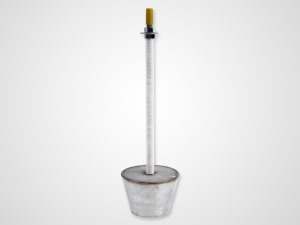The performance characteristics of ramming material and its construction introduction
The performance characteristics of ramming material and its construction introduction
The electric furnace ramming material is prepared from a high proportion of granular and powdery materials and a very low proportion of binders and other components, and even all of them are composed of granules and powdery materials. Bulk materials for construction.
Because the ramming material is mainly used for the parts that are in direct contact with the molten material, it is required that the granular and powdery materials have high volume stability, compactness and corrosion resistance, and those used in induction furnaces should also have insulation.
The selection of the binder of the ramming material should be appropriate, some do not need a binder, and some only add a small amount of flux. Acidic ramming materials are commonly used as binders such as sodium silicate, ethyl silicate, silica gel, etc. Among them, dry ramming materials are mostly used. Borates; magnesium chlorides and sulfates are commonly used in alkaline ramming materials; organics and temporary binders with high carbon content that can form carbon bonds at high temperatures are also often used. Among them, dry ramming materials Add an appropriate amount of iron-containing flux. Glauber's salt is commonly used for chromium ramming materials.
Compared with other amorphous refractories of the same material as the ramming material, it is dry or semi-dry and loose, and a dense structure is obtained by strong ramming. Only when it is heated to the sintering temperature, the combination has strength.
After the ramming material is formed, different heating methods can be used to promote its hardening or sintering according to the hardening characteristics of the mixture. If it contains an inorganic chemical binder, it can be demolded and baked after it hardens to a considerable strength; it contains a thermoplastic carbon binder. After cooling, it has considerable strength before demoulding, and it should be quickly heated to coking before use; and does not contain a binder that hardens at room temperature, it is often sintered with a mold after tamping.
The material of ramming material is divided into: clay, high alumina, carbon, magnesia and dolomite.
(1) Construction and stirring of high-alumina (or clay) ramming material: firstly add the coarse and fine aggregates and binder (high-alumina cement) in the specified proportioning amount into a forced mixer for dry mixing for 12 minutes. Next, add a certain amount of water for mixing and stirring for about 5 minutes. Construction: The thickness of the mixed ramming material is 80100mm in one laying. The pneumatic hammer is used for continuous and uniform ramming until the number of reciprocations of the specified bulk density is reached.
(2) Construction of carbon ramming material Carbon ramming material can be constructed by cold ramming method or hot ramming method. At present, the cooling ramming method is commonly used and the construction is more convenient. The finished material should be used. The ramming carbon material can generally be put into use directly. Before the ramming carbon material is rammed, the carbon material is pre-crushed and heated evenly. The heating temperature depends on the mixing temperature of the finished material. After heating There should be no hard lumps in the carbon material, and the hammer should be heated to dark brown when ramming, and the material temperature should not be lower than 70 degrees Celsius.
(3) Magnesium ramming material construction Magnesium ramming material has two types of tar magnesia, brine magnesia, and is mostly used for converters, electric furnaces, copper reverberatory furnaces, flash furnaces and other furnace bottom positions. Tar magnesium Before construction of sand ramming material, coal tar should be heated to about 130 degrees Celsius for dehydration, and magnesia and iron oxide powder should be heated to above 110 degrees Celsius for drying.
When the bricklaying is completed, heat and dry the surface of the wet brickwork to remove the moisture (dry masonry does not need to be heated), and apply a layer of coal tar on the surface of the masonry. When tamping, mix Good ramming material is poured in layers, the thickness of each layer is 7080mm, the compression ratio is 50%, and the ramming is usually carried out from the center of the furnace to 4 weeks, so as to prevent the oil from being squeezed to the center to form a soft spot (spring body). Ramming The wind pressure is not less than 0.5Mpa. The ramming method of brine magnesia ramming material is the same as that of tar magnesia ramming.

Related Industry Knowledge
- Features and Benefits of Coil Clay
- What are the advantages of a good furnace lining
- Misunderstandings in the use of ramming materials in intermediate frequency furnaces
- Phenomenon analysis of failure of argon blowing of ladle permeable bricks and how to improve the rate of argon blowing
- Where is the consumption reduction and energy saving of breathable bricks reflected?
- How to improve the service life of intermediate frequency furnace lining
- Reasons for damage to intermediate frequency furnace lining and how to solve them
- The performance and advantages of breathable brick
- Analysis of Structural Characteristics of Dispersive Breathable Bricks
- The intermediate frequency furnace charge knotting process needs to pay attention to details sharing
- What role does the coil glue play between the coil turns?
- What are the main performances of breathable bricks
- A brief introduction to the main manifestations of energy saving and consumption reduction of breathable bricks
- What are the performance and advantages of breathable bricks
- Furnace lining manufacturers briefly describe the reasons for the corrosion phenomenon of furnace surface lining
- How to deal with the damage of intermediate frequency furnace lining
- What are the precautions for the use of impermeable breathable bricks?
- Analyze the effect of coil cement products
- What are the differences between ramming material and castable material?
- What are the requirements for the production materials of breathable bricks?


